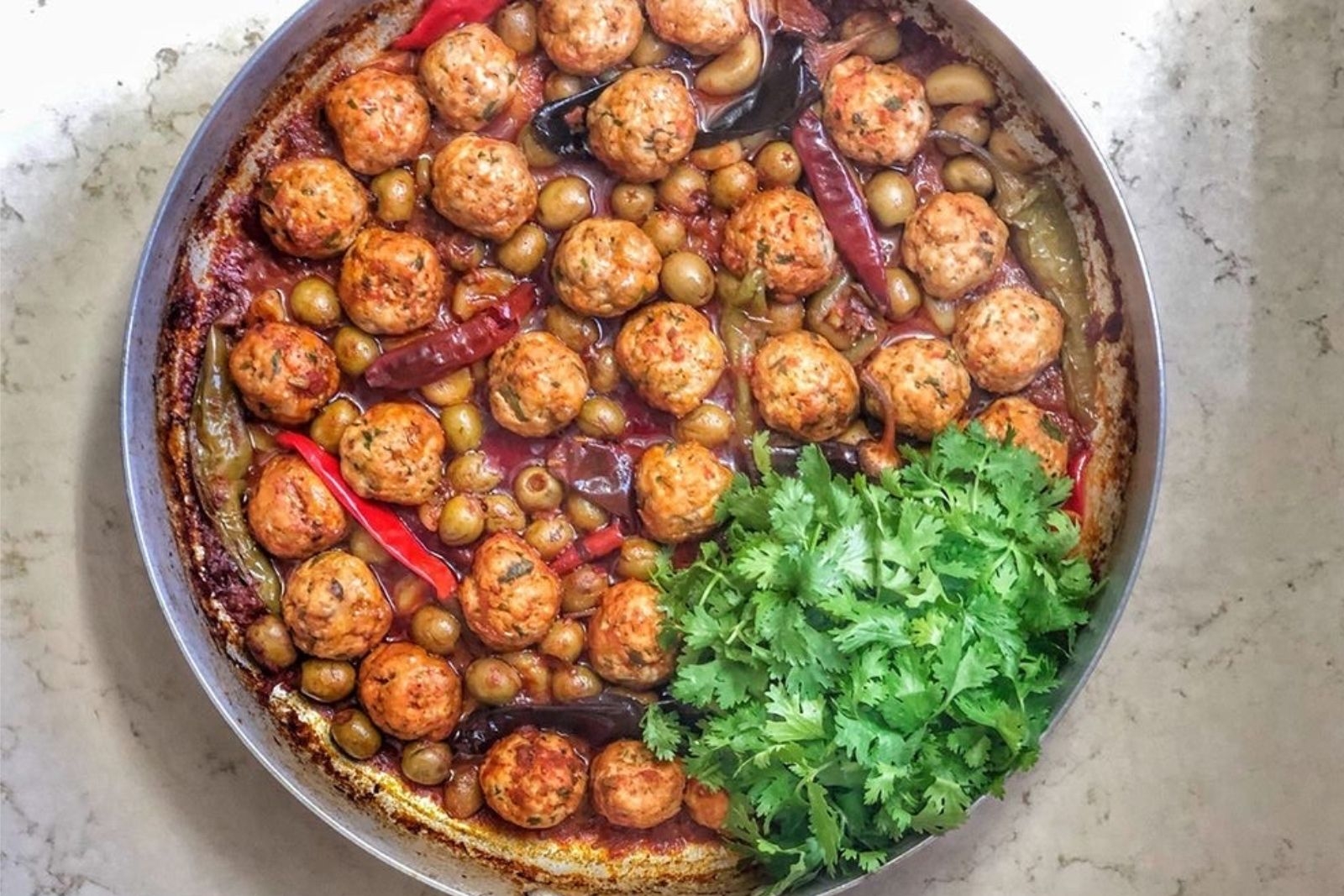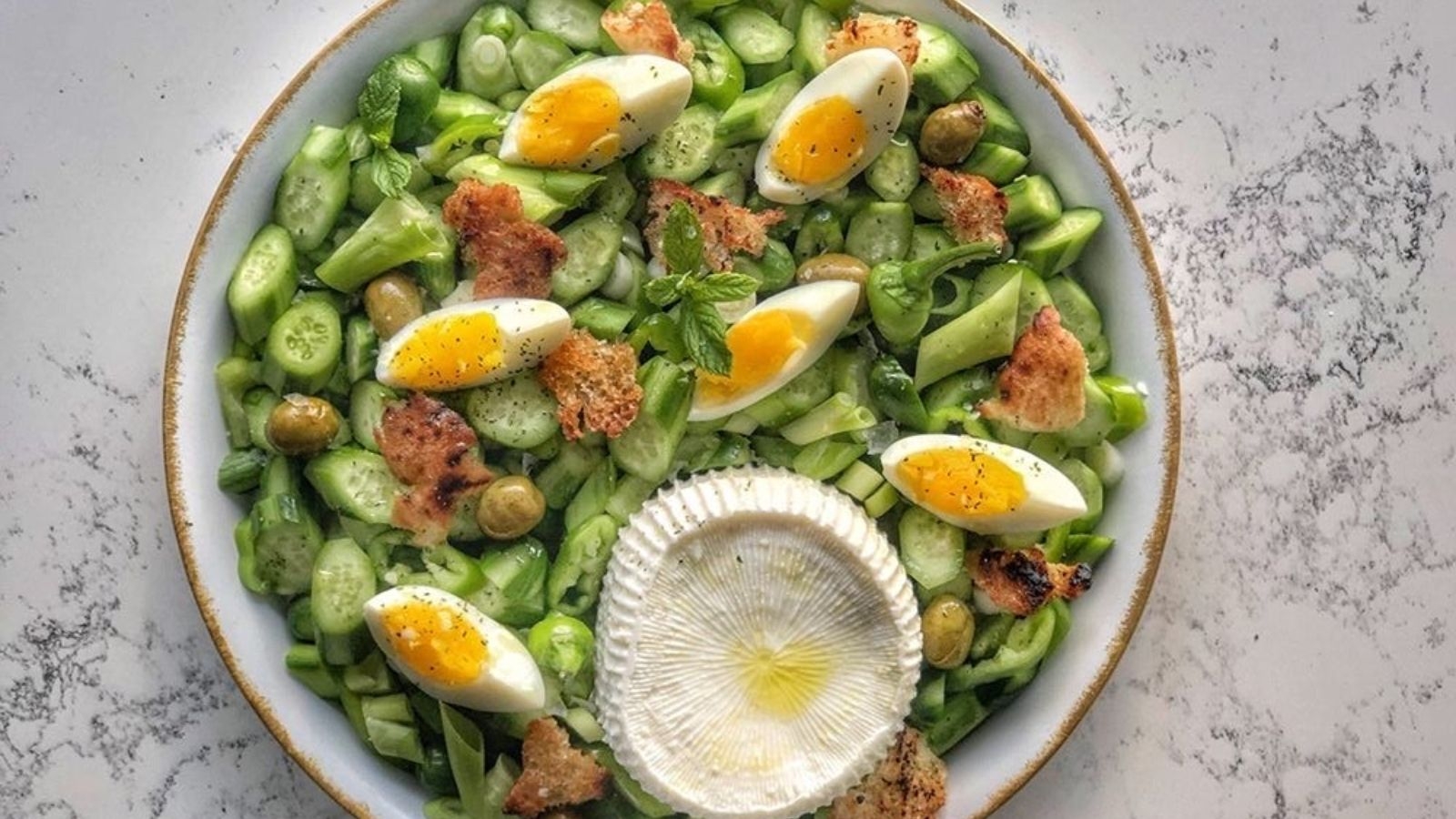I came across his Instagram page several months ago, and it stopped me mid-scroll. His food was beautiful, the vegetables carefully chopped, and he paid great heed to the colors on the plate. Most of his posts are variations on salads, with a piece of fish, shakshuka, and some schnitzel or two thrown in. In a sea of culinary images from every corner of the globe, his simple salads manage to stop me in my scrolling each and every time they appear on my feed. I immediately followed him and had to discover more.
Where to start? I googled him, of course: Amihai Beer. Lives in Sdot Yam, Hefa, Israel. Who was he? A chef? A caterer? Did he have a restaurant? A cooking school?
Turns out that Amihai Beer is none of the above. He doesn’t even own a decent set of knives. He buys everything he makes in the local grocery store. Yet in a small country like Israel, he has managed to rack up more than 40,000 followers on his Instagram account with carefully constructed yet simple plates.
Beer is also a lawyer, a businessman, and the chairman of his kibbutz, Sdot Yam, located in Caesaria in the northern part of Israel. He’s married with three young kids. Cooking is his hobby. His photos are so gorgeous that I find myself waiting each day to see what beautiful new food art he will share.
The Nosher celebrates the traditions and recipes that have brought Jews together for centuries. Donate today to keep The Nosher's stories and recipes accessible to all.
He agreed to speak to The Nosher to share his salad secrets.
Who gets to eat what you post?
Me and my wife! I only photograph what I eat. I like to eat a lot of vegetables, and it is important to me that they be interesting. I want food that is light, healthy, and beautiful. The Israeli kitchen has lots of legumes, vegetables, olive oil, and tahina.
What’s your process in deciding what to prepare?
I don’t keep a lot of food in my house. I shop every day, after work, in the local grocery store. I give myself 45 minutes a day to shop and cook dinner. Sometimes I ask myself what I want to eat and then see what is in the grocery store. Other times I decide what I want to eat based on what is available in the store. If I see nice okra, I may decide to make shakshuka with okra. I try to make food that is simple, easy, and quick.
What’s the most important element of a great salad?
Seasoning! Don’t be shy with the seasoning. You want extra-virgin olive oil, fresh lemon juice, mint, good coarse salt and sea salt, chopped hot pepper. Tahina. No vinegar. Just lemon. Fresh or dried za’atar.
What makes your salads so beautiful?
The plating. When I first started photographing my food, it was tasty, but in the photo you couldn’t feel the taste. I started to separate the colors to try to show the taste of the food through the photos. The order and the colors are a way of conveying taste.
Is there a particular vessel you use to display your food?
Beer: I often use a platter. Sometimes I use a bowl. It all depends on which way the food will look better. In the Israeli kitchen, we share a lot of food. It is more social. It is nice to eat together. It is easy. Most of the time I use simple plates — white, or a metal sheet pan, not unique. What pops is the food and the salad and the colors.
What sort of equipment do you use to cut your vegetables so perfectly?
I use no equipment. I have a simple knife and I cut everything by hand. I pay attention to cutting all of the vegetables the same size. You don’t, for example, want a big bite of carrot. When making a chopped salad, have all of the vegetables the same size so it is comfortable and easy to take a bite.
How do you decide how to lay out your food?
I consider color, then shape, and then the order in which I would like to eat the food. If I make a tray with falafel, I will put the pita on the left side of the tray and the fork on the right. There are no hard and fast rules. I will try to not put green near green. Cheese is often in the center of the dish so that it is easy to eat.
I noticed, though, that you recently posted an all-green salad!
Yes! That day I wanted to eat green food. I found salted, white cheese from Safed in my refrigerator, and I built a green salad around it. Chopped cucumbers, green onions, hot green pepper, sweet green pepper, green olives, hard-boiled eggs, fresh mint, dried mint, torn hunks of fried pita, lemon juice, and olive oil. Sometimes I go for one color. Sometimes two. Sometimes lots of them!
You seem to use cherry tomatoes more than larger tomatoes.
Cherry tomatoes are like candy to me. I like the small, round ones. I make pasta sauce out of them.

How do you feel about brown food?
Long-cooked dishes can be very tasty. I even like gefilte fish. But day by day I try to eat a lot of vegetables with a diversity of colors.
We notice that you don’t mix meat with milk in your food.
I wasn’t born in a religious house, but I don’t cook meat and milk together. I won’t cook pork or seafood either. I am connected to tradition as an Israeli and as a Jew. It is important to me.




